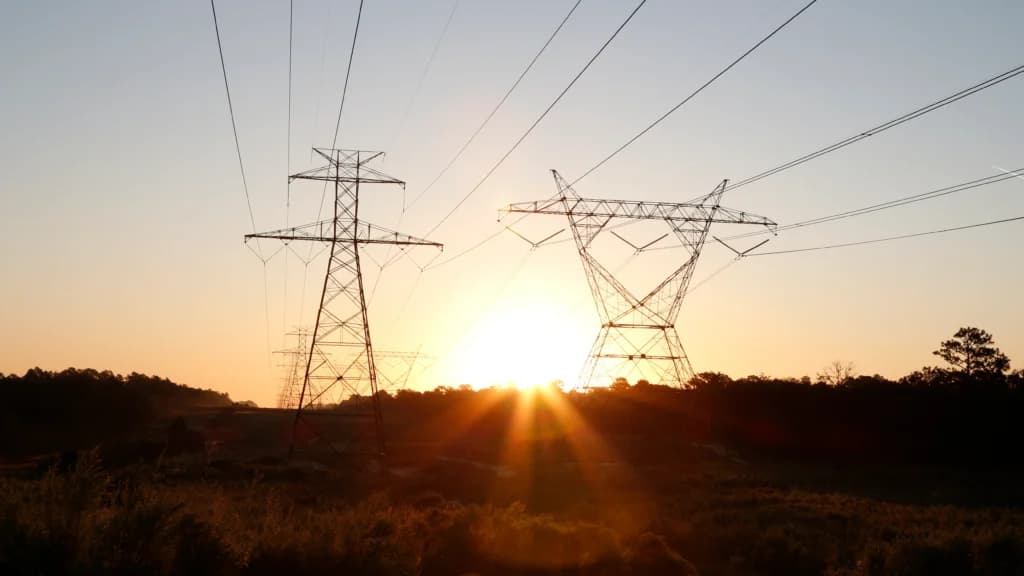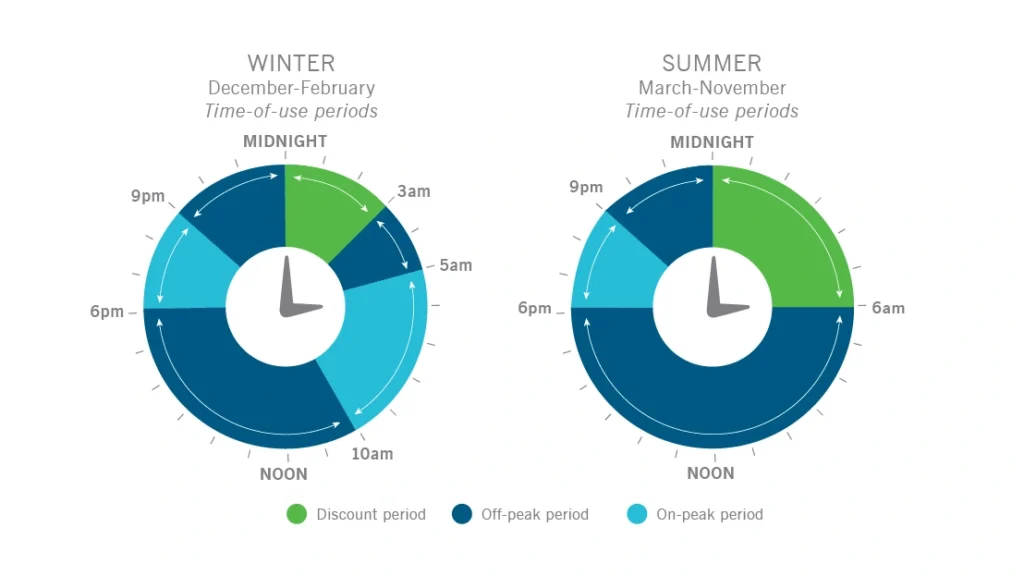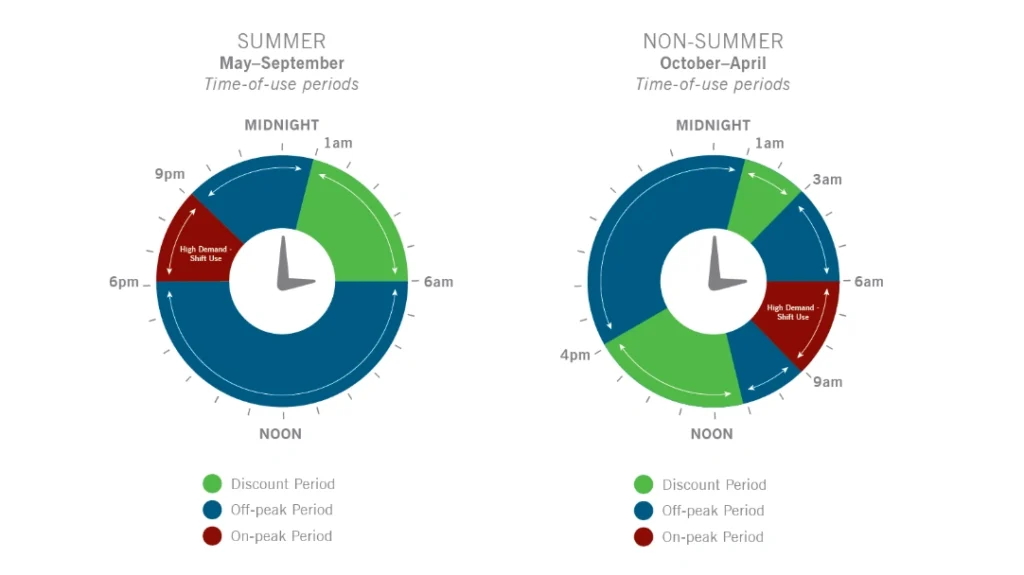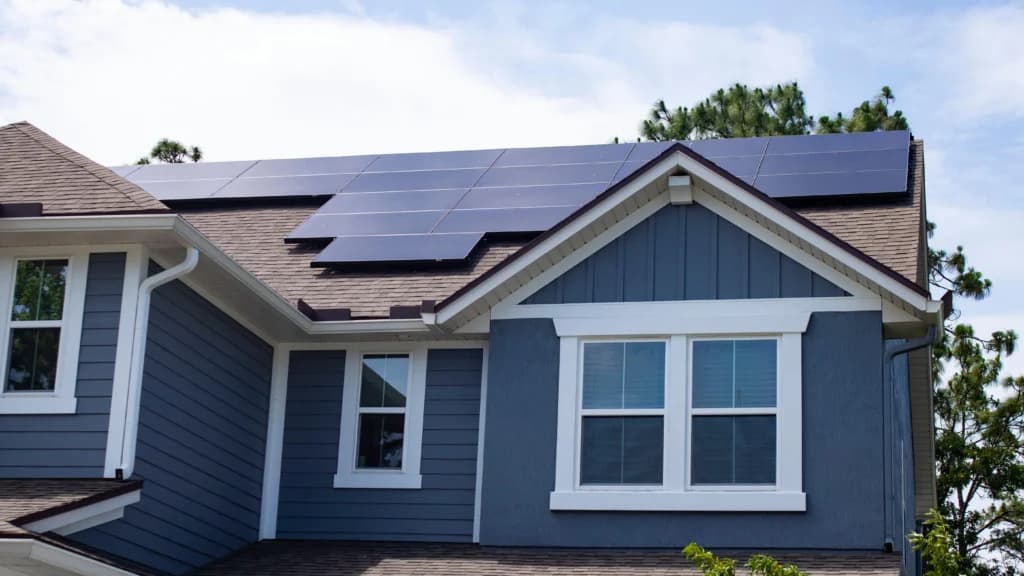
How to save money with smart energy pricing
Time-of-use (TOU) rates charge you more during peak demand and less when the grid is quieter. These plans can be a powerful way to shift energy use and lower costs, especially when combined with a solar power system at home. However, it’s important to understand TOU plans comprehensively before deciding if this is the right choice for your home.
Read on to learn how TOU works and how to tailor your schedule to put more money back in your pocket.
In this article:
- How TOU rates work
- Benefits of TOU pricing
- Challenges and considerations
- Tips for optimizing energy use with TOU rates
- Are TOU rates right for you?
How TOU rates work
With TOU rates, electricity prices vary based on the time of day. These rates reward consumers who shift their energy use to less demanding periods. To design TOU pricing, utility companies establish different rate periods throughout the day: peak and off-peak hours. Rates are higher during high-demand “peak” times and drop during lower-demand “off-peak” hours. This encourages consumers to adjust their energy use, which can save them money and help balance the grid.
It’s important to understand if a TOU plan is a choice or a requirement for you. For many homeowners, TOU rates are an optional program they can enroll in to manage their energy costs. However, in some areas like California, utilities now require new residential solar customers to be on a TOU rate plan. Always check your local utility’s policies to see which plans are available, what the rates are, and which may be mandatory for solar owners.
Peak vs. off-peak hours
Peak hours — when prices are highest — vary based on location, utility, and time of year, but typically fall during high-demand periods when most people are home and often using energy-intensive appliances. Most utilities set peak hours during late afternoon to early evening windows (commonly 4-9 PM or 5-8 PM) on weekdays. You’ll often find off-peak times late at night (or overnight), very early mornings, and on weekends when overall electricity demand is lower.

This distinction affects your bill and can influence how you schedule daily activities, like laundry, dishwashing, or charging an electric vehicle. To pinpoint your specific peak and off-peak windows, check your electric bill or visit your utility’s website.
Seasonal variations in TOU rates
In many regions, TOU rates adjust seasonally to reflect changing energy demand. According to the Energy Information Administration, electricity use often peaks in the afternoon (around 2–5 PM) during the summer and in the early morning (typically 7–9 AM) during the winter, driven by cooling and heating needs.
To match these patterns, utilities commonly define distinct on-peak periods for different seasons and service areas. For example, let’s compare how Duke Energy’s TOU plans differ in two states:
- Florida (RST-1 rate): Winter months (December–February) feature two daily on-peak periods, 5-10 AM and 6-9 PM. For summer months (March-November), only the 6-9 PM period remains on-peak.

- North Carolina (Duke Energy Carolinas & Progress): On-peak hours shift seasonally, with 6-9 PM in summer (May–September) and 6-9 AM in non-summer months (October–April).

These examples show that on-peak hours aren’t universal — they depend on your location, season, and utility rate plan.
Benefits of TOU pricing
TOU pricing offers several advantages by aligning electricity demand with supply. Shifting energy usage to off-peak hours can lower your energy bill and contribute to a more stable and efficient energy grid.
Cost savings opportunities
If you’re able to shift some of your energy use to off-peak times, you can save money with TOU rates. For example, running your dishwasher or laundry machine at night instead of during the peak afternoon period can cut down on costs over time. In Tampa Electric’s Energy Planner program, the cost per kilowatt-hour can decrease 2-3 cents during a low-rate time period — which can add up over time. (To learn more about energy savings, read Why Is My Electric Bill So High?)
Energy efficiency and grid stability
TOU rates reward energy use during off-peak hours. Shifting your usage not only saves money, it can help reduce strain on the grid at its busiest times, which can help utilities maintain reliability and operate more efficiently. In fact, TOU pricing is one example of a broader strategy known as demand response, which the U.S. Department of Energy highlights as a way to relieve peak demand stress and support grid reliability.
Challenges and considerations
Adjusting household energy use
One of the biggest challenges with TOU pricing is that it requires changing how and when you use energy. To save money, you’ll want to schedule high-energy tasks like cooking, laundry, or water heating during off-peak hours. This might mean preparing meals in advance and reheating them later, or setting programmable appliances to run when rates are lower. For many households, work and school schedules make this harder to do. Still, even small shifts like running the dishwasher at night or charging electronics while you sleep can make a noticeable difference over time.
What TOU rates mean for utilities
While TOU pricing is promoted as a way to reward smarter energy use, it’s also important to understand the utility’s incentives. These rate structures can also financially benefit utilities by concentrating the highest prices in the late afternoon and evening, precisely when solar production wanes and overall household demand ramps up. This creates a significant challenge for homeowners, who must not only adjust their daily routines but also navigate a rate structure that can be particularly difficult for unprepared solar users.
Compatibility with solar energy
Homeowners with solar face a timing mismatch under TOU plans because panels produce most power around midday, but many utilities set on-peak rates in the late afternoon to early evening, as production is falling. This timing mismatch, often called the “duck curve,” means you may find yourself exporting excess energy at lower credit rates, then buying back during on-peak hours at higher prices.

To maximize your savings:
- Add solar battery storage. Battery storage (like the Tesla Powerwall and other models) allows you to capture that midday solar surplus, then power your home with the battery during expensive peak hours.
- Evaluate panel orientation and sun exposure. The best location for your solar panels depends on your utility’s rate plan and any shading around your home. While a south-facing roof often maximizes total production, a west-facing roof can be more financially valuable in TOU markets — but only if it has clear, unobstructed access to the sun during the afternoon. A detailed shading analysis by an experienced installer is essential to identify the roof planes that will deliver the most value for your specific property.
- Check net metering or net billing rules. Some utilities credit exported solar at full retail value, while others use lower “avoided cost” rates. Check your utility’s solar policy online.
- Time high-energy loads right. As mentioned above, the time of day that you run things like your electric vehicle charger, laundry, or dishwasher makes a huge difference. With solar, you have the additional option of running these appliances during the day when your system might be exporting excess electricity to the grid at a low rate to avoid buying costly peak power.
- Review your utility’s TOU schedule alongside your solar output to tailor your energy usage plan.
Ultimately, a solar system must properly factor your home’s unique energy profile and your local utility’s rate structure. An experienced solar installer can analyze your current usage, account for future plans like adding an electric vehicle, and evaluate your specific rates to recommend the ideal setup — whether that’s a standard solar system or one that includes battery storage. With Aurora Solar, you can get and compare multiple quotes from our network of vetted installers to find the best partner and solution for your home.
Tips for optimizing energy use with TOU rates
Maximizing the benefits of TOU rates involves smart scheduling and technology. If you plan, you can ensure that most of your high-energy activities occur during cheaper off-peak times.
Best times to run appliances
Identify the windows in your utility’s schedule when energy rates are at their lowest and plan your appliance use accordingly. To get the most bang for your buck, schedule high-demand appliances like your dishwasher, washing machine, and water heater to run during off-peak periods — or when your solar system would be sending excess electricity to the grid at a low value. The more you shift, the more you save.

Consider staggering the usage of appliances to avoid creating a new demand spike. You can even install a simple energy monitor like Sense or Emporia to track your home’s load profile and automatically alert you when multiple big loads coincide, so you can tweak schedules and keep your rates low.
Smart home technology and TOU
Smart home technology can help you manage your energy use around TOU rates. Devices like programmable thermostats, smart plugs, and energy monitoring systems allow you to automate adjustments based on your utility’s TOU rate schedule. Many of these systems integrate with your utility’s rate schedules to alert you when prices drop or spike, allowing you to proactively shift energy-intensive tasks.
Some smart devices can even learn your routine over time and autonomously adjust settings to optimize energy use. These devices can also provide insight into your energy usage patterns to achieve a more efficient and cost-effective home energy system.
TOU and electric vehicles
For electric vehicle owners in areas with TOU or other EV charging incentives, these rates can cut charging costs when you plug your EV in during off-peak hours. This smart-charging strategy supports a more stable energy system, benefits your wallet, and contributes to lowering overall emissions. EV owners can learn more about identifying the lowest-cost electric rate from their energy provider. For example, Pacific Gas & Electric Company offers an overview of their residential EV rate plans and a calculator.
Are TOU rates right for you?
Understanding TOU rates empowers you to take control of your energy consumption and reduce your electricity bill. By shifting energy usage to off-peak hours, embracing smart technology, and adjusting household routines, you can enjoy cost savings and contribute to a more resilient energy grid — even if you’re a solar energy user.
Want to learn more about your energy consumption? Explore all of our Energy 101 articles.

